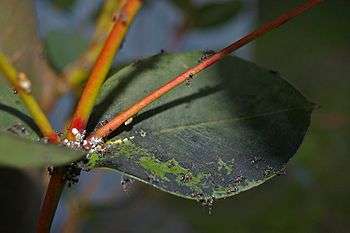Sooty mold

Sooty mold is a collective term for different Ascomycete fungi, which includes many genera, commonly Cladosporium and Alternaria. It grows on plants and their fruit, but also environmental objects, like fences, garden furniture, stones, even cars. The mold benefits from either a sugary exudate produced by the plant or fruit, or if the plant is infested by honeydew-secreting insects or sap suckers.
Sooty mold itself does little if any harm to the plant. Treatment is indicated, when the mold is combined with insect infestation.
Description
Sooty mold is a collective, self-descriptive term for a number of different fungi; it is a black, powdery coating adhering to plants and their fruit or environmental objects.
Biology
The ecology of the different species, their interactions, relationship to the host have been little understood. A chance obseravtion of a Microcyclospora tardicrescens inhibiting the growth of the fruit pathogen Colletotrichum fioriniae in dual culture tests, yielded trichothecolone acetate and its (S)-7-hydroxy derivative as active principles for the interaction between M. tardicrescens and C. fioriniae.
Genera causing sooty molds are Alternaria, Cladosporium, Aureobasidium, Antennariella, Limacinula, Scorias, and Capnodium.
Sooty mold grows particularly well on plants that produce a sugary exudate, if they are infested by honeydew secreting insects such as aphids, scales and the whitefly, or when infested by insects that suck sap from the host plant.[1]
Plants commonly affected
Sooty mold is commonly seen on the leaves of ornamental plants such as azaleas, gardenias, camellias, crepe myrtles, and laurels. Plants located under pecan or hickory trees are particularly susceptible to sooty mold, because honeydew-secreting insects often inhabit these trees. The honeydew can rain down on neighboring and understory plants. Occasionally citrus may exude sweet sticky secretions and sooty molds can grow on these.[1]
Effect
The fungus itself does little harm to the plant; it merely blocks sunlight, and very rarely may stunt a plant's growth and yellow its foliage. Thus, sooty mold is essentially a cosmetic problem in the garden, as it is unsightly and can coat most of a plant in a matter of days or weeks.
Control
The simplest form of non-chemical control is to wipe and wash affected plant parts with lukewarm water and soap, insecticidal soap or dish soap, one tablespoon per gallon of water; strong soaps or detergents may damage the plant. This can also be sprayed if the plant is large but is much less effective than when combined with physical removal. After allowing the soap to sit for a while the sooty mold is rinsed off with a hose/ water. Sooty mold will regrow, unless the underlying reason for its growth is eliminated.
Chemical control of sooty mold itself is not needed. If sap-sucking pest are responsible for the honeydew on which the mold is growing, there are several options:
Using formulations of neem oil, which is an organic broad spectrum pesticide, insecticide, fungicide and miticide controls mites and insects such as whitefly, aphid, scale, and mealy bugs, and additional fungus diseases like black spot, rust, mildew, and scab. Neem oil can be used on house plants, flowers, vegetables, trees, shrubs and fruit indoors and outdoors. Neem oil is biodegradable and has not been shown to be toxic to mammals, birds, bees, earthworms, or beneficial insects.
Synthetic insecticides such as the organophosphates acephate (orthene), malathion, or diazinon can be used in severe cases but read the labels for approved crops and days to wait to harvest.
See also
References
| Wikimedia Commons has media related to Sooty mold. |
- 1 2 "Sooty moulds". Royal Horticultural Society. Retrieved 16 July 2015.
Further reading
- Chomnunti P., Hongsanan S., Aguirre-Hudson B., Tian Q., Peršoh D., Dhami M. K., Alias A. S., Xu J., Liu X., Stadler M., Hyde K. D. (2014). "The sooty moulds". Fungal Diversity. 66 (1): 1–36. doi:10.1007/s13225-014-0278-5.